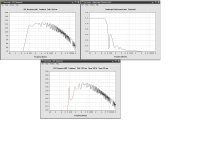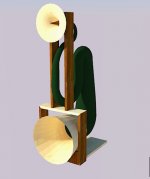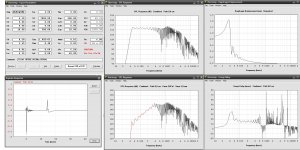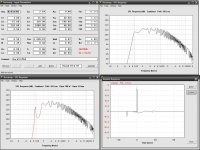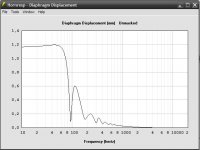Actually if you look at the Maximum SPL graph where the line is red is the point where it is reaching it's xmax. Now you'll probly notice I have this set at 3mm insted of the listed 1.95 (it will round to 2 anyway) because this is closer to what I believe the mechanical limit to be ergo the point where it will really start to sound bad. I will post the figure at 2mm instead (it doesn't reduce maximum as much as you would imagine) and yes below the usable frequency it moves a lot but I would always you a good high pass filter with these anyway (like the one built into most AV receivers and processors.)
Okay here are the graphs for the Sax cabs including the cone movement at 2.83 Volts. It is well within Xmax at all freq. at this level and is playing quite loudly as you can see by the response graph. (remeber this design has 4 drivers) and I redid the max spl graph at 2mm instead of 3.
Attachments
Whoa!!!! I had two of these once out of a little portable mp3 player! They were amzing for their size in a little bit of a plastic enclosure too!
Wondering if that bottom graph might smooth a bit if pmax was closer to rms for the 4 drivers, not max input. The 18db valley @ 130ish is of concern.
Edit: ok, i see now.....the bottom graph is just the extremes of operation
Edit: ok, i see now.....the bottom graph is just the extremes of operation
Last edited:
Smoothness isn't an issue that is just telling you the loudest you can play them at each given frequency it's not a response graph.
As I mentioned earlier the red line is where it is limited by Xmax and the blackline is where it is limited by max power. The graph is pretty meaningless above 2K or so because the response is controled by factors that Hornresp doesn't model at those frequencies, such as diaphram shape and dispertion patterns.
Here's a design I made for four of the 1" drivers in a unity horn type compound horn configuration. The mouth section and the front horn are lathe spun maple while the frame and phase plug are walnut. The rest of the horn would be molded out of plastic or fiberglass.
Attachments
well that is hogwash. theres the 'accepted standard' or whatever you want to call it, which may or may not be seen as correct anymore, that says 1dB is the smallest incremental change the ear can hear. i tend to think its less than this, at certain frequencies at least. at frequencies lower than maybe 150 hz, perhaps our ears are less sensitive, but 6dB is easily noticable.<snip>
It is 1.5db for pure tones, or a "JND", 3dB is a noticeable difference - for pure tones. For other things, like white noise and pink noise under some conditions far smaller differences are quite obvious. Also and apparently the harmonic structure of complex signals (like a voice, for example) show up small differences that sometimes are marginally measureable.
It's not so straightforward, imo.
_-_-bear
Edit: brsanko, the ripple you see (large in some cases) is due to too small of a mouth area to reproduce bass as a horn... the design is likely more like an end fed TL with a port of some sort on the end...
Last edited:
What your mentioning here is audible changes in volume. It is almost unrelated to variances in frequency response of a system. There is no speaker in the world with a flat frequency response in any room. Every acoustic environment out there creates changes in response and in the case of average size rooms in peoples homes we are talking about changes on the order of 15-20dbs within a very small range. All I am trying to say is that in these environments if your speaker has small variances of 3-6db in response you are not going to notice because regardless of how perfect your speakers are these peaks and valleys are going to be there.
i have to agree that i like the idea of all this, i just wonder if maybe a little too much.
i agree in the validity of a horn for such a driver, however in practice and despite your experience, Brsanko, I have found that the TB w2-800sl at least, produces significant THD and IMD when overdriven beyond the stated Xmax. the mech xmax seems to be more like 3mm each way. within the xmax and just beyond it, all is well. clean articulate and other buzzwords. but at a couple of watts, maybe 5 watts, the little beggars scream for mercy.
Its not a real criticism, and i cannot claim to have experienced the same with the 1"ers, but i think that your are still much better off staying within xmax. also i have found that going beyond 0.5 to 1m² mouth area difficult to justify since the bass capability is limited, in a front loaded horn at least. corner loading, as i think youre planning, is pretty much necessity with these drivers too i reckon. As i said im no expert on hornresp, and havent managed to figure out a BLH for these yet, or a F & BLH 🙁 which i really want to try.
i agree in the validity of a horn for such a driver, however in practice and despite your experience, Brsanko, I have found that the TB w2-800sl at least, produces significant THD and IMD when overdriven beyond the stated Xmax. the mech xmax seems to be more like 3mm each way. within the xmax and just beyond it, all is well. clean articulate and other buzzwords. but at a couple of watts, maybe 5 watts, the little beggars scream for mercy.
Its not a real criticism, and i cannot claim to have experienced the same with the 1"ers, but i think that your are still much better off staying within xmax. also i have found that going beyond 0.5 to 1m² mouth area difficult to justify since the bass capability is limited, in a front loaded horn at least. corner loading, as i think youre planning, is pretty much necessity with these drivers too i reckon. As i said im no expert on hornresp, and havent managed to figure out a BLH for these yet, or a F & BLH 🙁 which i really want to try.
because, lets face it, I WANT THESE TO WORK as much as you do lol, ill have to fiddle with hornresp and see if i can get something close 😉
because, lets face it, I WANT THESE TO WORK as much as you do lol, ill have to fiddle with hornresp and see if i can get something close 😉
I to find this intriguing. A couple of points and then I'll leave this alone to hopefully be built with success, because it is a visually exceptional design if executed well.
The driver in question, outside the context of this thread, IS a limited bandwidth mid/tweeter.....that's the misnomer here. With that said, we could all fiddle with hornresp from now till 2012 (pun). I would confidently guess that Mr. Mcbean never intended for the low/midbass response of such a driver be accurately modeled in hornresp. There's a few things here that a horn (unless corner loaded with 8-16 per side and of mammoth proportions) is going to have a hard time getting around.......sensitivity (lack of), thermal power handling, xmax, very small cone area even despite the use of multiple drivers, compression when asked to play too far below Fs, etc, etc. The oversight here is the thinking that a horn loading is going to surpass all the physical/mechanical/thermal limitations of the driver.
The combination of all this limits the design to 200hz IMO.....I'm unclear as to whether this is the OP's intent. As I've mentioned before.....build a wideband OB sub to cover from there down and you have a cohesive badass design, but standing on it's own in a full scale listening space?
Last edited:
in essence i agree as ive settled with 200Hz+ lower corner myself, but i would like to think the limitations maybe partly overcome, and their effects maybe not audibly terrible; that alone makes it worth a shot. even with the bandwidth ive chosen im not expecting miracles
🙄
🙄
What your mentioning here is audible changes in volume. It is almost unrelated to variances in frequency response of a system. There is no speaker in the world with a flat frequency response in any room. Every acoustic environment out there creates changes in response and in the case of average size rooms in peoples homes we are talking about changes on the order of 15-20dbs within a very small range. All I am trying to say is that in these environments if your speaker has small variances of 3-6db in response you are not going to notice because regardless of how perfect your speakers are these peaks and valleys are going to be there.
Hey, I have no beef with your project at all...
But I do not agree with what you just said. The on-the-ear or to-the-ear response of a speaker starting with a flat response is quite different than a speaker without a flat response. While it is true that a measuring system will integrate all energy arriving at a measurement point, the ear does not quite work that way. Also, consider a response that is let's say +/- 6db (whether this is real world or not, it's an example for clarity), ok? Now add in floor bounce and variations due to reflections within the time domain that the ear interprets as part of the original signal, so let's say that causes a +/- 6dB variation (let's just say it). Now, you have variations of up to +/-12dB across the spectrum. You will hear that when compared to a speaker with "flat" response placed in the same room in the same position. It will likely be worse in most regards. Very likely - I mean one might have a "magic" room where the deviations in the room are exactly the inverse of the speaker, but that never happens.
There is something to be said for an on axis response without significant amplitude variations wrt frequency (this is what I mean by "flat" - rather than flat amplitude from 20-20kHz...) because of the effect upon timbre and tonality. There is more to it than just the on-axis "flatness". You can ask why most major recording studios go to great lengths to assure maximal "flatness" of the response curve. 😀
Another issue is that the result of the "too small horn" is a comb filter - this can really effect tonality and timbre.
At least this is how I seem to recall it...
I'm not saying not to build the projects at all, because this is all relative to what you were listening to before the project, it may well be an improvement, in which case it is worth building for sure! 😀
No one starts at a point of perfection, and perfection is highly relative anyhow...
regards from bearlandia! 😀
_-_-bear
The driver in question, outside the context of this thread, IS a limited bandwidth mid/tweeter.....that's the misnomer here. we could all fiddle with hornresp from now till 2012 (pun).Mr. Mcbean never intended for the low/midbass response of such a driver be accurately modeled in hornresp. There's a few things here that a horn (unless corner loaded with 8-16 per side and of mammoth proportions) is going to have a hard time getting around.......sensitivity (lack of), thermal power handling, xmax, very small cone area even despite the use of multiple drivers, compression when asked to play too far below Fs, etc, etc. The oversight here is the thinking that a horn loading is going to surpass all the physical/mechanical/thermal limitations of the driver.
The combination of all this limits the design to 200hz IMO
Well I guess I can understand why you feel that way (kind of) but my personal experience has proven you wrong on all acounts. All of the factors you have mentioned are not only modeled by hornresp, acuratly to boot, but are well within reasonable parameters in this design. Sensitivity is almost not even a factor in a compound horn design, these drivers have exceptional Xmax (narly 2mm) I can't help but wonder if you're even looking at my posts because I show all of this informatio in my simulations. Not only will these speakers play down to 50hz they will do it quite loudly. These are in fact sold as full range drivers and the reason they have a recomended crossover at 200hz is that they won't play lower than that that at a decent volume in anything other than a horn, and for some reason the good people at Parts Express seem to not understand that horns exsist. I feel the simulations that I have done provide for me more proof than I have seen than there is to support the exsistance of the planet Mars. But like I said before when I build them I won't be shring the design anymore I'll be selling it. We have already built a set of small bookshelf speakers with these drivers that will play down to 80hz at a good deal more than 100db when I said the pop at loud volumes I meant at really loud volumes. Plus a design with 8 of these drivers will thermally handle 320Watts and they hit 120db at about 3 Watts so yeah not an issue. I just don't understand why people keep bringing up the same points that have already been addressed and insisting thing are impossible that I've already done and then telling me they want concrete proof as if they think I am a lier. Seriously what would I possibly gain by making fantastic claims to a bunch of people I will never meet and that really don't care to begin with. I don't WANT these drivers to work in my designs I have as far as I'm concerned prooven that they will. Like I have said numerous times Hornresp has acurately predicted the response of all 18-20 designs that we have built with it so far. One of which was a very small bookshelf design with one each of this driver and an F3 of 80hz it plays very nicely it just pops if you seriously crank it up with heavy bass music and no filter.
For someone who is soooo touchy about opposing/alternate opinions, you sure are quick to quote my posts and omit certain dialogue to make me seem presumptuous. Just sayin......but I'm not that touchy, so I won't rant about it.
This will likely curdle your blood........but I'm afraid the motto here is, "build first, brag later".
This will likely curdle your blood........but I'm afraid the motto here is, "build first, brag later".
Not trying to brag, I didn't make the speakers or write the software, just trying to share. Editing was done to show which comments I was addressing not trying to skew your intentions. I'm excited about what I've discovered, trying to share that excitment, check it out if you like, if you don't, well then don't.
youre right.
it will work.
it would still work, without any design work.
i have no doubt they play fullrange. quality of repro below 200hz is questionable. if only in the group delay plot, things are far from perfect, or even good. Judging by those particular plots, i would expect 200-20k to be brilliant; but unfortunately sub 200hz appears about as tight as a soggy paper bag.
without meaning to be rude or derogatory, this is a limited experiment/project. real clean articulate bass, i think is truely out of the question. to me the project is far more interesting as a mid-HF horn, and i reckon in this form, used within it limitations, it is a great idea.
I, for one, would be interested to see any measurements you may take in the future.
it will work.
it would still work, without any design work.
i have no doubt they play fullrange. quality of repro below 200hz is questionable. if only in the group delay plot, things are far from perfect, or even good. Judging by those particular plots, i would expect 200-20k to be brilliant; but unfortunately sub 200hz appears about as tight as a soggy paper bag.
without meaning to be rude or derogatory, this is a limited experiment/project. real clean articulate bass, i think is truely out of the question. to me the project is far more interesting as a mid-HF horn, and i reckon in this form, used within it limitations, it is a great idea.
I, for one, would be interested to see any measurements you may take in the future.
Okay here are the graphs for the Sax cabs including the cone movement at 2.83 Volts. It is well within Xmax at all freq. at this level and is playing quite loudly as you can see by the response graph. (remeber this design has 4 drivers) and I redid the max spl graph at 2mm instead of 3.
the bottom graph is interesting, as i believe another poster commented. i cannot quite read the y axis increments on the posted graph, but the red 'max excursion' line starts at about 80 hz.
this is fine for single tones....any intermodulation products in the signal, such as a chord(lol) a 5th/7th/3rd whatever will introduce IMD products with a beat frequency of greater amplitude than this.
in simple terms xmax will run out alot quicker than expected, with anything but the most spectrally sparse material. and this is with 4 drivers! i think i read that correctly.
still think its a great idea/experiment. just not for low frequencies.
Here are the graphs for my most abitious design the 50hz spiral design with 8 drivers. If you look at the first two graphs this is the one watt response. It is reaching 112db all the way down to 45 hz, and is not appoaching Xmax at any frequency. The graph you were refering to was the maximum SPL graph and the fact that the line is red simply means that it runs out of excursion before it over heats. The saxaphone desingn is meant to extend to 100hz and it does so upto 115db before hitting Xmax at any frequency, if crossed over at 100hz it will hit 120db. The last pic I attatched is the cone excersion at 1 watt (110db 90hz+) as you can see Xmax is not a factor even unfiltered. So basically if you want to crank them up loud you need a crossover but this 200hz limit is silly.
Looking at the graph I just posted the group delay seems to be about the same from about 55hz up to 600hz where it suddenly shifts because that is where response switches to the front horn. The only area that might be a problem is between 45-55hz (below that is outside the passband of the response) But this speaker will also play to 115db full band unfilterd before aproaching Xmax and if crossed over at 60hz 127db is possible. So while deep bass is not practical for these drivers due only to group delay good bass response down to 50hz is not only possible but can be exceptional as the impulse response is still the finest I have ever seen from any design. I know, I know somebody is going to come back with well then just build it, keep it to yourself you've already said it.
Looking at the graph I just posted the group delay seems to be about the same from about 55hz up to 600hz where it suddenly shifts because that is where response switches to the front horn. The only area that might be a problem is between 45-55hz (below that is outside the passband of the response) But this speaker will also play to 115db full band unfilterd before aproaching Xmax and if crossed over at 60hz 127db is possible. So while deep bass is not practical for these drivers due only to group delay good bass response down to 50hz is not only possible but can be exceptional as the impulse response is still the finest I have ever seen from any design. I know, I know somebody is going to come back with well then just build it, keep it to yourself you've already said it.
Attachments
- Status
- Not open for further replies.
- Home
- Loudspeakers
- Full Range
- This little driver seems to outperform everything else!
